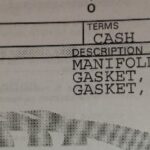Experiencing the frustrating P0442 code on your Ford vehicle? This OBD-II trouble code signals “Evaporative Emission Control System Leak Detected (small leak)” and can be a common issue, especially in older models like the Ford F150. While your truck might seem to run fine, that persistent check engine light and the fault code are indicators of a problem within your vehicle’s emission system that needs attention. Let’s dive into what Ford code P0442 means, common causes, and how you can address it.
The Evaporative Emission (EVAP) system is designed to prevent fuel vapors from escaping into the atmosphere. A P0442 code indicates a small leak within this closed system. This leak, even if minor, can be enough to trigger the check engine light and fail emission tests. While a P0442 code doesn’t typically cause immediate drivability issues, neglecting it can lead to more significant problems down the road and environmental concerns.
Several components can contribute to a P0442 code in your Ford:
- Loose or Faulty Gas Cap: Often the simplest and most frequent culprit. A gas cap that isn’t properly tightened or has a damaged seal can allow vapors to escape.
- Purge Valve Issues: The purge valve controls the flow of fuel vapors from the EVAP system to the engine. If it’s stuck open or malfunctioning, it can create a leak.
- Cracked or Damaged Hoses and Lines: The EVAP system uses various hoses and lines to transport fuel vapors. Over time, these can become brittle, cracked, or disconnected, leading to leaks.
- Charcoal Canister Problems: The charcoal canister stores fuel vapors until they can be purged into the engine. Damage or leaks in the canister itself or its related lines can cause a P0442 code.
- Fuel Filler Neck Issues: Specifically, damage to the fuel filler neck, especially the sleeve where the gas cap seals, can be a source of small EVAP leaks. As highlighted in the original scenario with the Ford F150, a chipped or damaged filler neck sleeve can prevent a proper seal, triggering the P0442 code.
If you’re encountering a P0442 code on your Ford, here’s a step-by-step approach to diagnosis and repair:
-
Inspect the Gas Cap: This should always be your first step. Remove and reinstall the gas cap, ensuring it’s tightened until it clicks. Check the gas cap for any visible damage to the seal. If in doubt, replacing the gas cap is an inexpensive starting point.
-
Visual Inspection of EVAP System Components: Carefully examine all accessible EVAP system hoses and lines for cracks, disconnections, or damage. Pay close attention to the fuel filler neck area, checking for any damage to the sleeve or neck itself.
-
Professional Smoke Test: If visual inspection doesn’t reveal the leak, a smoke test is often necessary. A smoke machine introduces a safe, visible smoke into the EVAP system. The location where smoke escapes indicates the source of the leak. This test is best performed by a qualified mechanic.
-
Purge Valve Test: A mechanic can test the functionality of the purge valve to ensure it’s operating correctly and not stuck open, causing a leak.
-
Addressing Fuel Filler Neck Damage: If, like the original poster, you suspect damage to the fuel filler neck sleeve, this requires careful consideration. While temporary fixes like epoxy might seem appealing, they are generally not recommended for fuel system components due to safety and durability concerns. Replacing the fuel filler neck is often the most reliable and long-term solution, ensuring a proper seal for the gas cap and resolving the P0442 code. Consulting a professional mechanic is advisable for fuel filler neck replacement due to the safety precautions involved in working with the fuel system.
While addressing a P0442 code might seem daunting, starting with simple checks like the gas cap and visual inspections can often pinpoint the problem. For more complex issues, especially those related to the fuel filler neck or requiring smoke testing, seeking professional diagnosis and repair is recommended to ensure the EVAP system is properly sealed and your Ford runs efficiently and cleanly.

